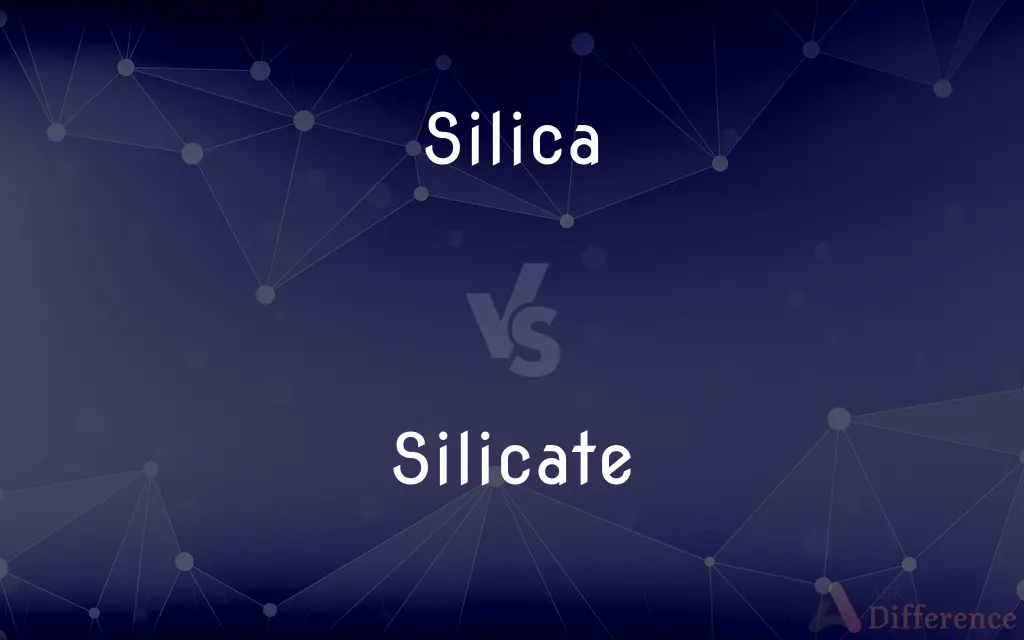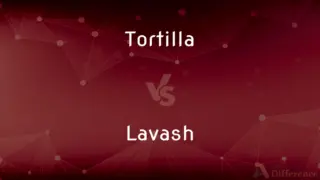Silica vs. Silicate — What's the Difference?
By Urooj Arif & Fiza Rafique — Updated on March 1, 2024
Silica is a chemical compound composed of silicon and oxygen (SiO2), naturally occurring as quartz and used in various industries. Silicates are a broader group of minerals containing silicon, oxygen, and metals, forming the majority of the Earth's crust.

Difference Between Silica and Silicate
Table of Contents
ADVERTISEMENT
Key Differences
Silica, specifically silicon dioxide (SiO2), is a fundamental component of sand, quartz, and certain types of crystals. It is widely recognized for its hardness and chemical inertness, making it invaluable in industries such as glass manufacturing, electronics for semiconductor production, and as a desiccant. Silicates, on the other hand, encompass a vast group of minerals that include silicon and oxygen atoms combined with various metal ions like aluminum, magnesium, and iron. These compounds form structures ranging from simple to complex, including frameworks, sheets, and chains, which are the building blocks of many rocks and clays.
The distinction between silica and silicates fundamentally lies in their composition and structure. Silica is a single, simple compound (SiO2), exhibiting a crystalline form in nature as quartz. Silicates, however, are characterized by their diverse and complex structures, with the silicon and oxygen tetrahedra at their core, linked in various arrangements and combined with other metallic elements. This diversity in structure gives rise to the wide range of silicate minerals, each with unique properties and applications.
From an application perspective, silica is often sought after for its purity and specific physical properties, such as its high melting point and strength. It is used in producing glass, silicon chips, and industrial abrasives. Silicates, given their abundance and variability, are crucial in construction materials (e.g., cement, bricks), ceramics, and as minerals in agriculture to enrich soil nutrient content.
The environmental and health impacts of silica and silicates differ, particularly in their dust forms. Inhalation of silica dust can lead to serious health conditions such as silicosis, necessitating strict regulatory controls in workplaces. Silicate minerals, while also subject to dust-related health concerns, vary in their impact based on their specific composition and the form in which they are encountered.
Silica and silicates are closely related through their silicon-oxygen chemistry, their distinctions lie in their chemical structure, diversity, and range of applications, reflecting their unique roles in both natural and industrial contexts.
ADVERTISEMENT
Comparison Chart
Composition
Silicon and oxygen only.
Silicon, oxygen, and other metals.
Structure
Crystalline, no metal ions apart from silicon.
Complex structures with silicon-oxygen tetrahedra and metal ions.
Natural Occurrence
Quartz, sand.
Majority of Earth's crust, including rocks and clays.
Applications
Glass manufacturing, semiconductors, desiccants.
Construction materials, ceramics, soil minerals.
Health Impact
Inhalation can lead to silicosis.
Varies by mineral type, some less harmful than others.
Compare with Definitions
Silica
Acts as a desiccant.
Silica gel packets are used to absorb moisture and protect goods.
Silicate
Minerals forming the Earth's crust.
Feldspar and mica are common types of silicate minerals.
Silica
Natural occurrence as quartz.
The quartz crystal is a popular form of naturally occurring silica.
Silicate
Variable health impacts.
While some silicate dusts are harmful, others pose less risk.
Silica
A hard, crystalline mineral used in glass making.
Silica is the primary component of window glass.
Silicate
Used in construction materials.
Silicates are key ingredients in cement and bricks.
Silica
Used in semiconductor industries.
High-purity silica is crucial for producing computer chips.
Silicate
Diverse structures with metallic elements.
Silicates can form in sheets, chains, or three-dimensional networks.
Silica
Health risks from dust inhalation.
Workers are protected from silica dust to prevent silicosis.
Silicate
Enhance soil nutrients.
Silicate minerals are added to soil to improve plant growth.
Silica
A white or colorless crystalline compound, SiO2, which in the form of quartz and certain other minerals is a chief component of the earth's crust. Silica sand is used in making a wide variety of materials, such as glass and concrete.
Silicate
In chemistry, a silicate is any member of a family of anions consisting of silicon and oxygen, usually with the general formula [SiO(4−2x)−4−x]n, where 0 ≤ x < 2. The family includes orthosilicate SiO4−4 (x = 0), metasilicate SiO2−3 (x = 1), and pyrosilicate Si2O6−7 (x = 0.5, n = 2).
Silica
Silicon dioxide.
Silicate
Any of numerous compounds containing silicon, oxygen, and one or more metals; a salt of silicic acid.
Silica
Any of the silica group of the silicate minerals.
Silicate
Any of a large group of minerals, forming over 90 percent of the earth's crust, that consist of SiO2 or SiO4 groupings combined with one or more metals and sometimes hydrogen.
Silica
Silicon dioxide, SiO . It constitutes ordinary quartz (also opal and tridymite), and is artifically prepared as a very fine, white, tasteless, inodorous powder.
Silicate
(inorganic chemistry) Any salt of silica or of one of the silicic acids; any mineral composed of silicates
Silica
A white or colorless vitreous insoluble solid (SiO2); various forms occur widely in the earth's crust as quartz or cristobalite or tridymite or lechartelierite
Silicate
A salt of silicic acid.
Silicate
A salt or ester derived from silicic acid
Common Curiosities
How do silica and silicates differ in structure?
Silica has a simple crystalline structure of SiO2, while silicates have more complex structures with silicon-oxygen tetrahedra linked in various arrangements and combined with metals.
What are common uses of silica?
Common uses include glass manufacturing, electronics for semiconductors, and as a desiccant.
Are all silicates the same?
No, silicates vary greatly in composition, structure, and properties, leading to a wide range of applications.
What are silicates?
Silicates are minerals composed of silicon, oxygen, and various metals, forming a significant part of the Earth's crust.
How are silicates used in construction?
They are used in materials such as cement and bricks due to their strength and durability.
What makes silica important in technology?
Its high purity and physical properties make it essential for producing silicon chips and other semiconductor devices.
What is the environmental impact of silica and silicate mining?
Mining can lead to land degradation, water pollution, and habitat destruction, though impacts vary by method and location.
Why are silicates so abundant in the Earth's crust?
Their chemical stability and the abundance of silicon and oxygen in the Earth's mantle contribute to their widespread presence.
Can silica be used in food?
Yes, silica is used as an anti-caking agent in powdered foods and as a health supplement.
What is silica?
Silica is a chemical compound consisting of silicon and oxygen, known as silicon dioxide (SiO2), found in nature as quartz.
Can silica dust be harmful?
Yes, inhaling silica dust can lead to serious respiratory diseases like silicosis.
Do silicates have any role in agriculture?
Yes, certain silicate minerals are used to enrich soil nutrients and improve plant growth.
Is there a health risk associated with all silicates?
Health risks vary; some silicate minerals can be harmful when inhaled, while others are less so.
How is silica extracted?
Silica is commonly extracted from quartz sand or mined from quartzite rock.
Are silica and silicates renewable resources?
While they are abundant, their renewal through natural processes is extremely slow, making sustainable management important.
Share Your Discovery

Previous Comparison
Tortilla vs. Lavash
Next Comparison
Pierrot vs. ClownAuthor Spotlight
Written by
Urooj ArifUrooj is a skilled content writer at Ask Difference, known for her exceptional ability to simplify complex topics into engaging and informative content. With a passion for research and a flair for clear, concise writing, she consistently delivers articles that resonate with our diverse audience.
Co-written by
Fiza RafiqueFiza Rafique is a skilled content writer at AskDifference.com, where she meticulously refines and enhances written pieces. Drawing from her vast editorial expertise, Fiza ensures clarity, accuracy, and precision in every article. Passionate about language, she continually seeks to elevate the quality of content for readers worldwide.














































